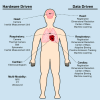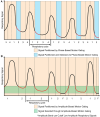Motion-correction strategies for enhancing whole-body PET imaging
- PMID: 39118964
- PMCID: PMC11308502
- DOI: 10.3389/fnume.2024.1257880
Motion-correction strategies for enhancing whole-body PET imaging
Abstract
Positron Emission Tomography (PET) is a powerful medical imaging technique widely used for detection and monitoring of disease. However, PET imaging can be adversely affected by patient motion, leading to degraded image quality and diagnostic capability. Hence, motion gating schemes have been developed to monitor various motion sources including head motion, respiratory motion, and cardiac motion. The approaches for these techniques have commonly come in the form of hardware-driven gating and data-driven gating, where the distinguishing aspect is the use of external hardware to make motion measurements vs. deriving these measures from the data itself. The implementation of these techniques helps correct for motion artifacts and improves tracer uptake measurements. With the great impact that these methods have on the diagnostic and quantitative quality of PET images, much research has been performed in this area, and this paper outlines the various approaches that have been developed as applied to whole-body PET imaging.
Keywords: cardiac gating; data-driven gating; hardware-driven gating; motion correction; positron emission tomography (PET); respiratory gating.
Conflict of interest statement
Conflict of interest AM is a consultant for Weinberg Medical Physics. The remaining authors declare that the research was conducted in the absence of any commercial or financial relationships that could be construed as a potential conflict of interest.
Figures






References
Grants and funding
LinkOut - more resources
Full Text Sources

